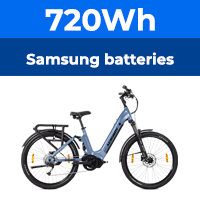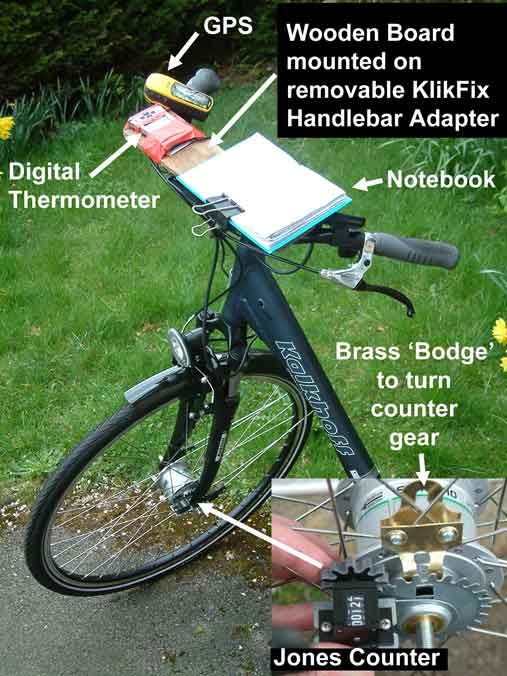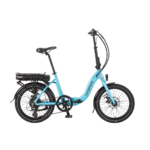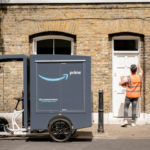So now I am experiencing the flaw in the battery driven electric transport concept - the time spent waiting for the battery to charge.
My brand new Kalkhoff Agattu 3G arrived at 0817 this morning. I had had the 8Ah battery replaced with one of the new 18Ah batteries.

By 0845 I had the battery on charge. My watt meter showed it was taking 60 watts from the mains. If I guess that the charger + charging process is 75% efficient, then there must be 1.667 amps going into the battery if at 27 volts.
The 18Ah battery will take about 10 45 mins to charge, before I can try the bike. Sod this, I had better fix up the bike for measuring and try it out under pedal power alone.

Here you see I have mounted the geared Jones Counter on the front axle and made a bodge so it will turn the gear as the front wheel turns. The rev counter will read about 26 counts per revolution of the front wheel. So 1 count will correspond to 10.9 cm forward movement of the bike.
My GPS will record my route and also acts as a real time speedometer. The digital thermometer records the temperature, which affects the tyre circumference and hence the calibration of the Jones Counter. I moved the Klickfix handlebar adapter from my old push bike to the new one, so my notebook is held in a convenient position.
Fixing up that took me about 3 hours, and the first light on the battery had only just switched from flashing to steady. 4 more lights to go, so at this rate the battery won't be charged until dark. I could not wait any longer to try the bike. It would just have to be unassisted pedal power. So over the next hour I did 6 miles on almost flat roads, and got some good calibrations of counts per km using a calibration course which I have laid out nearby.
It is quite windy today, so I am little slow into the wind. But with the wind on my aft quarter I found 10 mph very comfortable. Coming back I took in a short hill, and my speed dropped to about 5 mph in 1 st gear. Despite the extra weight of the bike compared with my push bike, I got up the hill quite as normal even though I have nothing like the gear range of my 21 speed push bike. Coming down the other side the bike's front and aft suspension soaked up the bumps and at 17 mph I could ride safely over the bumpy part of the road, rather than having to follow the smooth route I take on my push bike. The comfort of the new bike's suspension is a revelation to someone used to the jarring and vibration of an unsprung bike.
So my outing convinced me that if I ever do manage to run this big capacity battery flat I shall be able to get home unaided.
Now, how is that battery getting on:
08:45 - put on charge after a few minutes first light starts flashing. (It was a bit disconcerting that there were no lights at first but I saw 60 watts going in, so assumed all was OK.)
11.25 (2 hr 40 mins elapsed) first light steady - 2nd light start to flash
13.25 (further 2 hr elapsed) 2nd light steady - 3rd light flashes
15.15 (further 1hr 50 mins elapsed) 3rd light steady - 4th light flashes
17.08 (further 1hr 53 mins elapsed) 4th light steady - 5th light flashes
18.48 (further 1hr 40 mins elapsed) 5 lights on steady. There is 66 watts still being taken from the mains. The manual implies I have to wait for the lights to go out for full charge. Presumably the lights are measuring battery voltage and 5 lights is Voltage when fully charged but with no charging current flowing. So there is further charging required.
I still can't see that it will be charged before dusk. So it will have to be an early ride tomorrow morning to test out the bike under power.
At about 2020 the wattage started ramping down, as the charge level was "topped off". here is the ramp down recorded time and watts
circa 20:15 - 67 watts
20:10 -51 watts the 5 lights had been illuminated for 1 hr 22min when this ramp down commenced
20:32 - 36 watts
20:39 - 31 watts
20:42 - 29 watts
20:47 - 26 watts
20:52 - 24 watts
20:55 - 22 watts
20:59 - 7 watts All five lights went out at this point. The 7 watts is just the charger idling power.
THE BATTERY IS FULLY CHARGED AFTER 12 hours 14 minutes (Initial Charge)
I know it has been said before, but wouldn't it be great to have standardised batteries and a national network of exchange stations. There would be no waiting for charging then.
My brand new Kalkhoff Agattu 3G arrived at 0817 this morning. I had had the 8Ah battery replaced with one of the new 18Ah batteries.

By 0845 I had the battery on charge. My watt meter showed it was taking 60 watts from the mains. If I guess that the charger + charging process is 75% efficient, then there must be 1.667 amps going into the battery if at 27 volts.
The 18Ah battery will take about 10 45 mins to charge, before I can try the bike. Sod this, I had better fix up the bike for measuring and try it out under pedal power alone.

Here you see I have mounted the geared Jones Counter on the front axle and made a bodge so it will turn the gear as the front wheel turns. The rev counter will read about 26 counts per revolution of the front wheel. So 1 count will correspond to 10.9 cm forward movement of the bike.
My GPS will record my route and also acts as a real time speedometer. The digital thermometer records the temperature, which affects the tyre circumference and hence the calibration of the Jones Counter. I moved the Klickfix handlebar adapter from my old push bike to the new one, so my notebook is held in a convenient position.
Fixing up that took me about 3 hours, and the first light on the battery had only just switched from flashing to steady. 4 more lights to go, so at this rate the battery won't be charged until dark. I could not wait any longer to try the bike. It would just have to be unassisted pedal power. So over the next hour I did 6 miles on almost flat roads, and got some good calibrations of counts per km using a calibration course which I have laid out nearby.
It is quite windy today, so I am little slow into the wind. But with the wind on my aft quarter I found 10 mph very comfortable. Coming back I took in a short hill, and my speed dropped to about 5 mph in 1 st gear. Despite the extra weight of the bike compared with my push bike, I got up the hill quite as normal even though I have nothing like the gear range of my 21 speed push bike. Coming down the other side the bike's front and aft suspension soaked up the bumps and at 17 mph I could ride safely over the bumpy part of the road, rather than having to follow the smooth route I take on my push bike. The comfort of the new bike's suspension is a revelation to someone used to the jarring and vibration of an unsprung bike.
So my outing convinced me that if I ever do manage to run this big capacity battery flat I shall be able to get home unaided.
Now, how is that battery getting on:
08:45 - put on charge after a few minutes first light starts flashing. (It was a bit disconcerting that there were no lights at first but I saw 60 watts going in, so assumed all was OK.)
11.25 (2 hr 40 mins elapsed) first light steady - 2nd light start to flash
13.25 (further 2 hr elapsed) 2nd light steady - 3rd light flashes
15.15 (further 1hr 50 mins elapsed) 3rd light steady - 4th light flashes
17.08 (further 1hr 53 mins elapsed) 4th light steady - 5th light flashes
18.48 (further 1hr 40 mins elapsed) 5 lights on steady. There is 66 watts still being taken from the mains. The manual implies I have to wait for the lights to go out for full charge. Presumably the lights are measuring battery voltage and 5 lights is Voltage when fully charged but with no charging current flowing. So there is further charging required.
I still can't see that it will be charged before dusk. So it will have to be an early ride tomorrow morning to test out the bike under power.
At about 2020 the wattage started ramping down, as the charge level was "topped off". here is the ramp down recorded time and watts
circa 20:15 - 67 watts
20:10 -51 watts the 5 lights had been illuminated for 1 hr 22min when this ramp down commenced
20:32 - 36 watts
20:39 - 31 watts
20:42 - 29 watts
20:47 - 26 watts
20:52 - 24 watts
20:55 - 22 watts
20:59 - 7 watts All five lights went out at this point. The 7 watts is just the charger idling power.
THE BATTERY IS FULLY CHARGED AFTER 12 hours 14 minutes (Initial Charge)
I know it has been said before, but wouldn't it be great to have standardised batteries and a national network of exchange stations. There would be no waiting for charging then.
Last edited:








